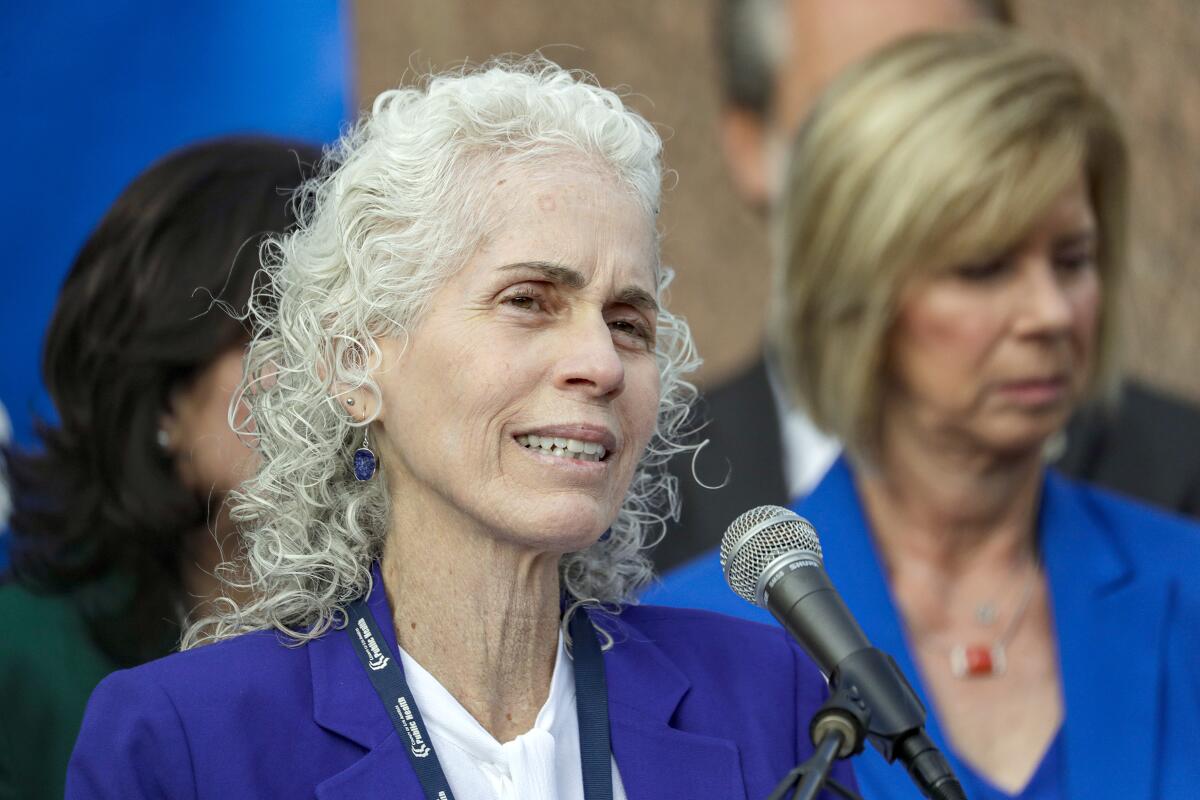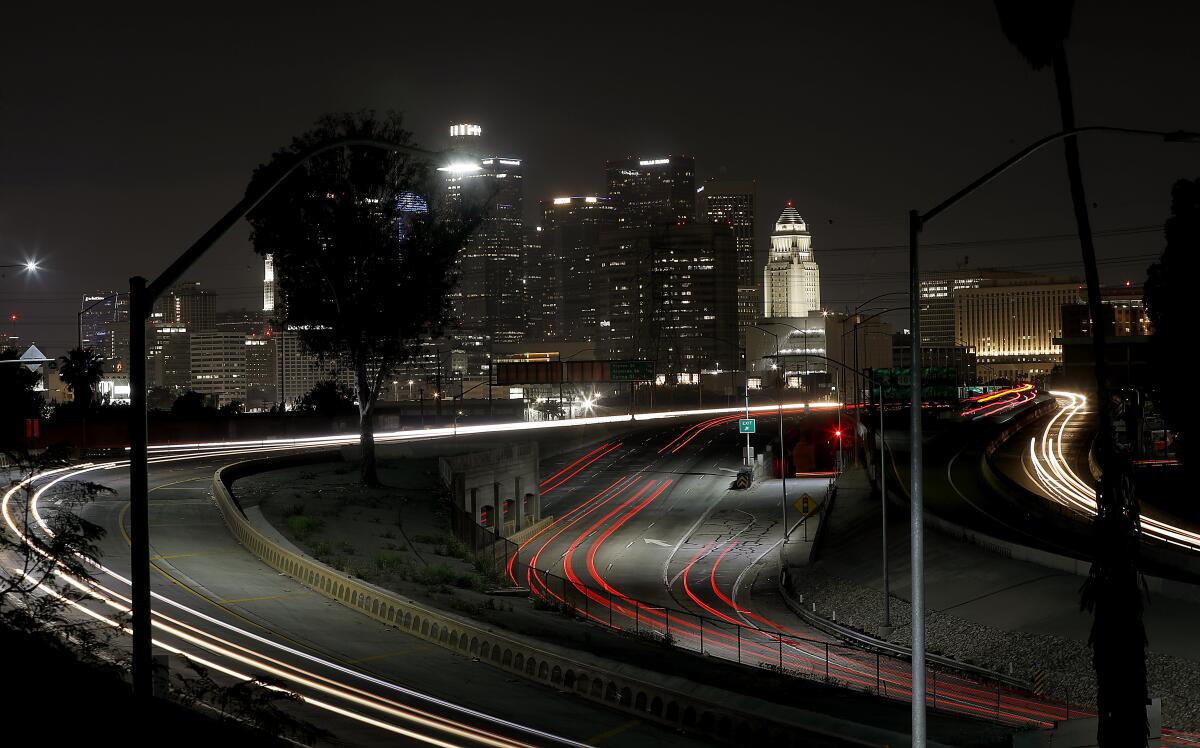Newsletter: Sit this week out at home if you can

- Share via
Good morning, and welcome to the Essential California newsletter. It’s Tuesday, April 7. I’m Nita Lelyveld, filling in for Julia Wick, and I’m writing from Los Angeles.
Sign up for Essential California
The most important California stories and recommendations in your inbox every morning.
You may occasionally receive promotional content from the Los Angeles Times.
L.A. County health officials say this week could be a pivotal one as we try to flatten the curve and control the spread of the coronavirus here. Stay home, the county’s public health department director Barbara Ferrer urged residents. Don’t even go shopping, she said, if you can possibly avoid it.
Virus cases and deaths in the county keep rising. As of Monday night, 147 county residents had died and the number of cases had reached at least 6,390.
But here’s the thing: We don’t really know how many cases we’ve had either in L.A. County or in California or in the nation as a whole because of the many problems with getting people tested. Gov. Gavin Newsom acknowledged this weekend that testing lapses have made it hard to track the virus in the state.
So, officials — while desperate to improve our odds here — don’t have all the information they need to know exactly where we stand now or when we’ll hit peak crisis.
Good data is important, and the Los Angeles Times is trying to do its part to help. In recent weeks, The Times’ data team has built its own statewide coronavirus tracker that is far more up to date than the numbers issued by the state. More than a dozen Times staffers are involved in the effort, which involves checking the websites of dozens of health agencies around the state five times daily, every three hours from 9 a.m. to 9 p.m., I’m told by Ben Welsh, our data and graphics editor.
On Monday, The Times announced that it is sharing its coronavirus database publicly, in an effort to help scientists, researchers and others who are trying to get a grip on the crisis.
“Not just here in California but all around the world the coronavirus has outpaced governments’ ability to grapple with it. And that’s been true in a lot of different elements of the governments’ function, most importantly things like hospitals and travel and commerce,” Welsh told me. “But one other way that governments have struggled to keep up with the coronavirus is just simply tracking the number of cases and deaths that are happening out there.”
Early on, when the coronavirus first emerged in China, Johns Hopkins led the way with data by independently collecting it far faster than government agencies.
“We weren’t the only ones who saw the gaps,” Welsh told me of the official California data, which is days behind real time. “The epidemiologists, the mathematicians, the local fire and police officials, the people at every level of government were looking for the latest information. And what they found is that we had it before they did.”
On the first day our database went public, Welsh told me, researchers at UC San Francisco’s medical school launched a website to cross-reference The Times’ data with other factors such as age, race and income — to try to better understand who is getting sick as a first step in figuring out how to better to reach out to and protect the most vulnerable.
Here’s hoping that these efforts can make a difference.
And now, here’s what’s happening across California:L.A. STORIES
They’re out in front, at their own peril. The coronavirus is hitting our first responders hard. Los Angeles Times
Crowded quarters: A lot of people in L.A. live in co-living apartments, sharing space with many roommates as a way to afford L.A. rent and to find community. That can be a challenge and a comfort right now. Los Angeles Times
Keep your distance: What is it with those people who have the luxury of being able to social distance but still aren’t doing it? Los Angeles Times
Sticking close to home: When you stay home, you might begin to see your familiar surroundings with fresh eyes. Los Angeles Times
Stay home if you can. But if you do go out: Watch your speed on our newly empty streets. Law enforcement is cracking down. Los Angeles Times
Want to get tested for the virus? Mayor Eric Garcetti says that any L.A. County resident can now apply online to get tested. That doesn’t mean you’ll get a test tomorrow, but testing capacity is growing. Los Angeles Times

POLITICS AND GOVERNMENT
We’re still waiting for the worst, but some are in it already. California isn’t expecting its coronavirus peak until mid-May, and we now have more than 11,000 ventilators. So we’re loaning 500 to the Strategic National Stockpile to help places in the country that are COVID-19 hot spots now, Newsom announced Monday. Los Angeles Times
Think Social Security and unemployment benefits. Past crises have changed our country in big ways. This one probably will too. Los Angeles Times
Who gets the vote on when we vote? Emergency authority over elections is not so clear. ProPublica
Enjoying this newsletter?
HEALTH AND THE ENVIRONMENT
Moving mountains: Will our hospitals have all the supplies they need in time? Los Angeles Times
Tracking hospital beds: Where are ICU beds filling up the fastest in California? Sacramento Bee
Shifting sounds: How the pandemic has changed what we hear out in our world. Associated Press
CALIFORNIA CULTURE
From Elvis to coronavirus: In Carlsbad, an Elvis impersonator recasts himself as the coronavirus `Crisis Crooner.’ He’s not trying to make light, he says — just trying to make people smile about the tribulations of staying at home. San Diego Union-Tribune
Helping hands: If you’re an artist struggling during the coronavirus, there is some aid available out there. Los Angeles Times
For your amusement, hold the parks: Missing Disneyland? Take an “It’s a Small World” virtual boat ride. Los Angeles Daily News
Rising hopes: This is a pretty perfect coronavirus crisis gesture of kindness, particularly in San Francisco. Someone is leaving sourdough starter around the city. San Francisco Chronicle
CALIFORNIA ALMANAC
Los Angeles: rainy, 62. San Diego: rainy, 61. San Francisco: partly cloudy, 58. San Jose: partly cloudy, 62. Fresno: partly cloudy, 65. Sacramento: partly cloudy, 65. More weather is here.
AND FINALLY
Today’s California memory comes from Linda Stryker:
Back in the 1940s, there were no freeways. The ride to downtown took us past aromatic orange groves. We rode a trolley car to movie theaters to see first-run Disney films, overrun with screaming kids. We passed by the hillside funicular. Our family drove to the beach every Sunday (Seal Beach, Huntington Beach), where ice cream and burgers were treats. One day, my dad had to rescue me from the undertow. In the 1950s, I learned to drive in the Santa Anita Racetrack empty parking lot. Orange groves disappeared, freeways started to appear. L.A. was quiet back then.
If you have a memory or story about the Golden State, share it with us. (Please keep your story to 100 words.)
Please let us know what we can do to make this newsletter more useful to you. Send comments, complaints, ideas and unrelated book recommendations to Julia Wick. Follow her on Twitter @Sherlyholmes.
Sign up for Essential California
The most important California stories and recommendations in your inbox every morning.
You may occasionally receive promotional content from the Los Angeles Times.




